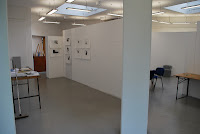The Shivering Sands and Redsands Maunsell Sea Forts were built in 1942
at Northfleet, Kent and are six-eight nautical miles off the East Kent
coast. They were created as anti-aircraft and observation platforms to
disrupt the German Luftwaffe on bombing runs to London.
The design and manufacture of these platforms was also the early fore runner for the oil platforms of today.
The forts are visible from the Kent and Essex
coastlines. They were de-commissioned in the
1950's,
but were brought, briefly back into use in the 1960s by pirate radio
stations. The forts have stood derelict and disused since then acting as a reminder of the past conflict.
Project Redsand has been established to secure the future of the Forts and the group
are working towards the listing of the Redsand Towers as a National
Monument and Heritage site. Late last year I was able to visit the site by fishing boat and board the towers for a couple of hours. I was fascinated and inspired by these futuristic and brutal looking structures. I managed to do a series of quick pencil studies and record video and sound from the top of one of the platforms. I then plan to use this reference to create a new body of work inspired by my trip to the Maunsell seaforts.




















